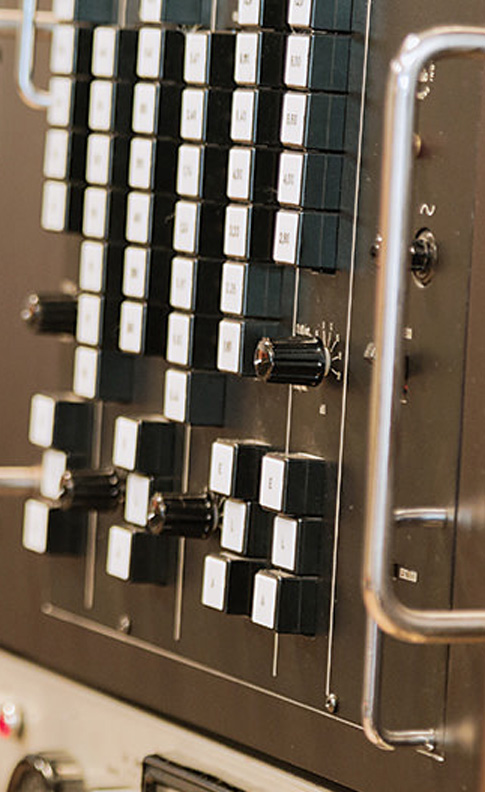MAAT's thEQorange is an update of the famous Algorithmix PEQ Orange linear EQ plug-in. The original Orange EQ (along with its Red sibling) were very popular with mastering houses. Users suggested that plug-ins were approaching the quality of hardware/dedicated digital processors. A series of events sidetracked Algorithmix, leaving the software stuck in 32-bit, Windows-only mode. Fortunately, in 2017 the team at MAAT negotiated approval to update various titles, and thEQorange is the first of these reissues.
Although original users would have been happy with nothing more than a 64-bit cross-platform version, MAAT was not content to stop there. Numerous graphic and usage improvements join this incarnation. The interface is crisp, resizable, and customizable. People either love or hate the spectrogram (which scrolls bottom to top), but if you don't like it, you can shut it off, enabling it only when needed.
Users can audition boosts-only, cuts-only, both positive and negative changes dialed in by the plug-in, or Normal mode where you can hear the summary result of the audio when convolved through the plug-in. The first three modes solo only what the EQ has changed, without any unaltered content. When enabled, a piano keyboard spans the bottom of the graphic window. You can play notes and use the spectrogram to move the keys left or right, so the filters align with the program material. (Very useful if you ever get a project recorded in 432 Hz vs. 440 Hz.) Convention holds that we layout the EQ left to right, starting with low frequencies and moving higher. In real use, we add bands as needed, sometimes working out of numerical order. If your EQ plug-in refuses to let you rearrange the bands, built-in mastering engineer OCD will strike. A sort function will automatically reorder, soothing those nagging voices.
Starting frequencies may be changed using FMODE. In addition to any full-range value, built-in settings can recall the bands found on beloved hardware units. Likewise, each filter can be applied to stereo, left, right, mono (mid) or difference (side). Most things in the interface can be hidden, or configured, including the colors. There are more features, but these were the ones I found the most value in daily use.
Let's consider the sound. Although I'm not a fan of linear phase EQ, I found thEQorange to be smooth and natural sounding. In particular, I appreciated it on low and low mid frequencies. For example, in a mix for Lance Whalen, a boot that accidentally clubbed the mic stand threatened to ruin an excellent performance. Spectral editing failed to create an ideal solution. I turned to the low cut filter on thEQorange. Extending the range to 10 Hz, with Q of .77 I shifted the curve to higher frequencies (eyes closed via scroll wheel mouse) and stopped when I found the best result. thEQorange was just right. Contribution control further confirmed I was removing only the offending thump. In carving out lo mids, I was reminded of respected solid-state mastering EQs – surgical without being brittle. None of this is to say that thEQorange is less than adequate on higher ranges; instead, this thing is a beast in the lower realms.
There was some vigorous response to the initial announcement for thEQorange. MAAT's original copy implied the code was both linear phase and not subject to the disadvantages inherent in this method. This description has been since clarified. There is latency with this plug-in, the buffer is a requirement for the processing calculations, and this EQ presents less audible pre-ring more than competing titles. Designed for mixing and mastering, thEQorange needs a fair amount of CPU to run. You won't be instantiating 36 of these in your session, but I doubt that would be necessary. Another point of friction lay in the price/authorization method. The preliminary cost was in line with a product born of substantial development hours. Users comparing it to $19 VST EQs missed the point; thEQorange is a different animal. MAAT will have updated pricing for original Algorithmix owners, new perpetual licenses, and a subscription. Likewise, more incarnations of the plug-ins are now included.
As of this writing, copy protection requires the new 3-Series CmStick from Wibu-Systems. Unobtrusive USB nubs, these dongles hold more licenses and are less likely to break off. A CmStick is necessary to demo or authorized thEQorange and can be purchased for $50. To offset this expense, the CmStick ships with a $50 voucher for future purchases at the MAAT store.
For mastering, mixing, and restoration work, thEQorange is a formidable tool. As someone who seems to cut more than I boost, I'm enamored with the sound and power of this title. To my ears, thEQorange sounds sweeter than many of competing plug-in EQs, making it a tool I can rely on day-in/day-out. Of course, as much as I appreciate thEQorange for its utility, at press time, we learned that thEQblue might be released soon. I'm already camping out for a demo.




_disp_horizontal_bw.jpg)